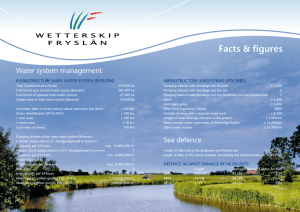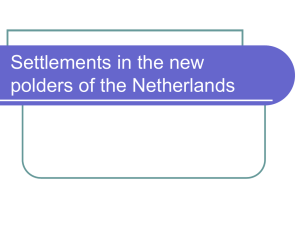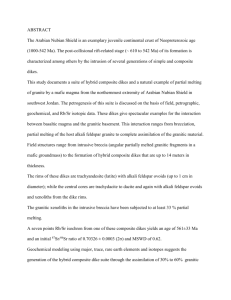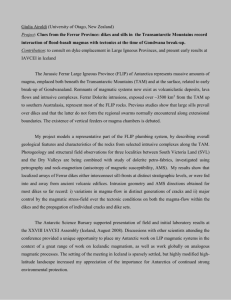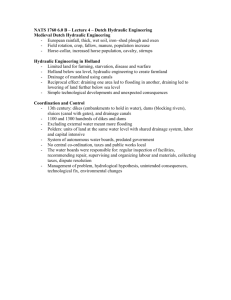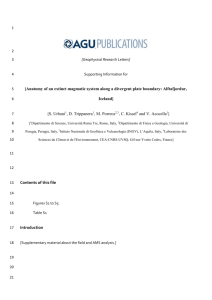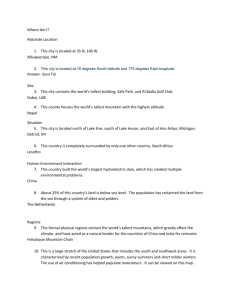safety sufficient water clean water
advertisement
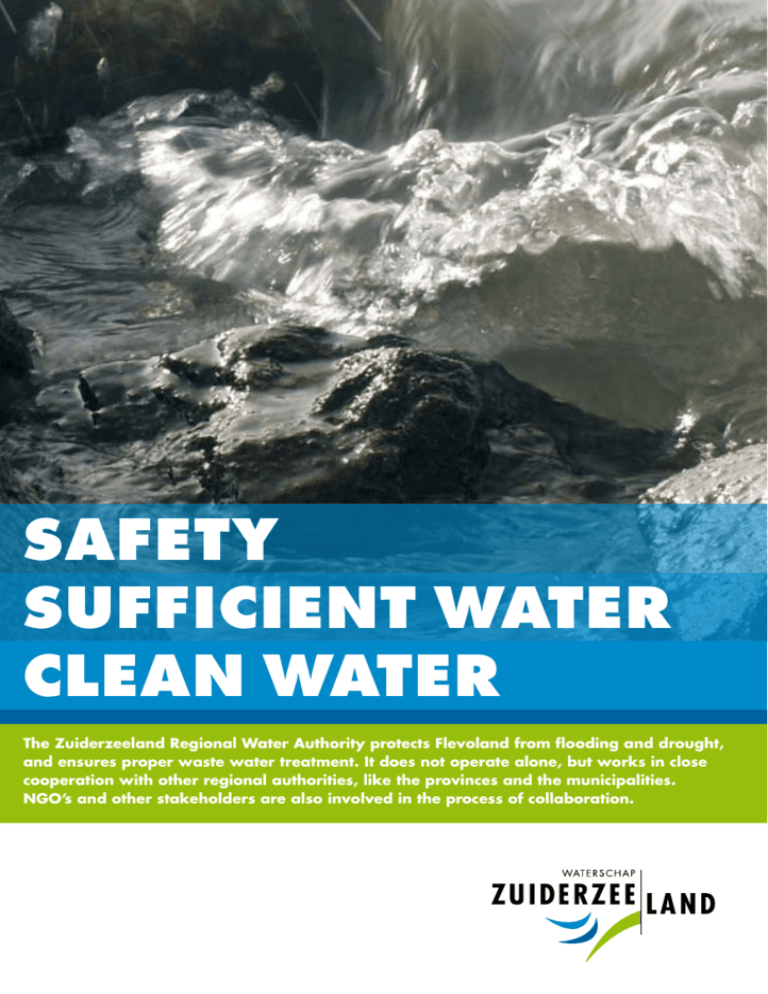
SAFETY SUFFICIENT WATER CLEAN WATER The Zuiderzeeland Regional Water Authority protects Flevoland from flooding and drought, and ensures proper waste water treatment. It does not operate alone, but works in close cooperation with other regional authorities, like the provinces and the municipalities. NGO’s and other stakeholders are also involved in the process of collaboration. Proper water management: essential for life Flevoland lives: many thousands of people live, work and relax here every day. The local flora and fauna make for a unique landscape. It’s easy to take all this for granted. However, sustaining this situation demands a great deal of hard work. If the Zuiderzeeland Regional Water Authority didn’t do its work properly, the polders would soon be flooded. At its lowest point, this ‘new land’ lies some five meters below sea level. Proper water management is essential for all life and requires more than just maintaining dikes. The water in the polders must constantly be kept at the correct level. Waste water has to be treated and must not pollute drainage ditches and lakes. In Flevoland too, open space is gradually disappearing. Thousands of extra homes and many hectares of industrial estates are required. These all demand space. Also, farmers want adequate farmland. SAFETY SUFFICIENT WATER CLEAN water Zuiderzeeland REGIONAL WATER AUTHORITY At the same time, there is an increasing desire for nature conservation areas and recreational facilities. The busier the polder gets, the greater the need for proper water management. But water also needs space. Close cooperation is essential to safeguard the space required for water. Which is why the Zuiderzeeland Regional Water Authority maintains close links with municipalities, provin­ces, other regional water authorities, various governmental and non-governmental social, environmental organisations (NGOs). And of course with residents. In this way, the Zuiderzeeland Regional Water Authority ensures that the interests of water are as wellpromoted as all the other interests. Working together on integrated water management for a safe, high-quality and attractive environment in an open and responsible manner. That is the task of the Zuiderzeeland Regional Water Authority. What is the Zuiderzeeland Regional Water Authority all about? The Zuiderzeeland Regional Water Authority manages the water in the polders of Eastern and Southern Flevo­ land and in the Northeast polder. This covers a total of 150 thousand hectares of land, in which some 370 thousand people live. The Zuiderzeeland Regional Water Authority also manages two peripheral lakes. Its tasks include maintaining the predetermined water level and the dikes, maintaining waterways, monitoring water quality and treating both domestic and industrial waste water. Moreover, Zuiderzeeland is responsible for combating muskrats in order to prevent damage to dikes and banks. It also coordinates the fight against botulism in the control area. Legend Pumping stations Main office G1: Vissering G2: Buma G3: Smeenge G4: Wortman Regional office G5: De Blocq van Kuffeler G6: Lovink G7: Colijn Waste water treatment plants 2 Pumping stations Waste water treatment plants Z1: Almere Z2: Dronten Z3: Lelystad Z4: Tollebeek Z5: Zeewolde Safety first Rising sea levels and the expected increase in precipitation require a greater commitment to keeping water at bay. The Zuiderzeeland Regional Water Authority does its best to keep Flevoland safe so that residents can expect dry feet in the future too. The dikes must be both strong and high enough to keep the water under control. Not just high enough for the highest water levels, but so high that even waves generated by the heaviest storms will not top them. Furthermore, structures not belonging to the dike itself, such as roads, cables, mains and buildings must not be allowed to weaken the dikes. The quest for strong dikes is a never-ending one. The Zuiderzeeland Regional Water Authority carries out effective maintenance, not only outside the dikes, but also within the area’s dikes and quays. The regional water authority maintains the grass on the dikes together with tenant farmers by allowing sheep to graze or by mowing. Muskrats are exterminated to prevent damage to dikes and watercourses. SAFETY 6 Finally, the Zuiderzeeland Regional Water Authority stipulates what is and is not permitted on the dikes. It assesses permit requests and issues fines for violations. All in the interest of polder safety. 7 Retain water as long as possible The Zuiderzeeland Regional Water Authority cannot prevent flooding (in the towns and villages, agricultural and conservation areas) with dikes alone. Water is continually seeping through and under the dikes (seepage): heavy showers can cause serious problems. The regional water authority has seven pumping stations at its disposal to pump excess water out of the polder. Conversely, the area can sometimes become too dry. The water level in the polder then falls, which can damage crops, for instance. In other words: ensuring sufficient water means sometimes pumping water out and sometimes letting it back in. In any case, it is essential that water has adequate space to move within the Zuiderzeeland Regional Water Authority’s control area. In due course, the Netherlands has become much more aware that, due to extreme weather conditions, it is not always possible to pump out all excess water to rivers, canals and lakes in time to avoid a crisis. SUFFICIENT WATER The challenge is to retain the water where it falls for as long as possible so that it cannot cause flooding in the lower-lying areas. To achieve this, all spatial developments must take greater account of the water. Whether constructing new residential areas, or industrial estates, or setting up conservation areas, systems have to be designed to ensure the capture and temporary retention of water where it falls. To realise this objective, the Zuiderzeeland Regional Water Authority collaborates with, among others, municipalities and various governmental and non-governmental environmental organisations. Actually, this presents an exciting challenge. After all, many people love water, whether in an urban or a natural setting. 8 9 Treating polluted water Vast amounts of polluted domestic and industrial waste water are generated in Flevoland. Each time the toilet is flushed, the bath is emptied or the washing machine is used, polluted water flows into the sewers. Businesses also produce waste water, with some industrial companies producing huge volumes. This water has to go somewhere. And to top it all, plenty of water drops from the skies and is collected in roof guttering and drains in the road where some is directed into the sewers. All told, more than a quarter of a billion cubic metres of waste water flows through the sewers of Flevoland annually. All this water wends its way to one of Zuiderzeeland Regional Water Authority’s five waste water treatment plants. These plants treat the polluted water - mostly using micro-organisms present in nature itself - and then discharge the treated water back into the surface waters. Waste water treatment is funded by the taxpayer. For the sake of the environment, and due to the costs, the Zuiderzeeland Regional Water Authority tries to limit the generation of polluted water. This is done by ensuring that businesses meet strict requirements before being awarded a permit to discharge waste water. CLEAN WATER Furthermore, the Zuiderzeeland Regional Water Authority is trying to ensure, often in cooperation with municipalities, that clean rainwater is no longer directed to the waste water treatment plants. After all, that water is not really polluted. This demands laying separate sewers: one for rainwater and one for domestic waste water. Though this is an expensive operation in existing residential areas, it is much cheaper when included at the design stage of new residential areas. In this way, the Zuiderzeeland Regional Water Authority ensures well-treated water at the lowest possible cost. 10 11 Zuiderzeeland Regional Water Authority in figures Water and nature belong together 150.000 hectares of land 7 major pumping stations 70.000 hectares of water 5 sub pumping stations The Zuiderzeeland Regional Water Authority concentrates on safety and on ensuring well-treated and sufficient water. At the same time, these activities must contribute to support natural habitats. The Zuiderzeeland Regional Water Authority aims to manage the dikes naturally where possible, in the hope that this will encourage rich undergrowth. This is coordinated with mowing and haymaking activities. 265 kilometres of dikes 59 sewage pumping stations and associated high-pressure pipelines and pumps to convey the waste water to the waste water treatment plants The Zuiderzeeland Regional Water Authority makes the banks along canals and ditches as natural (eco-friendly) as possible by removing the wooden piling. This helps to make the transition between water and land less dramatic. And this in turn provides plant and animal species that prefer to live between water and land a chance to flourish. These eco-friendly banks are also important for water retention. The Zuiderzeeland Regional Water Authority also ensures that residents unconnected to the sewerage system (because they live too far from the main sewers) receive their own so-called individual waste water treatment systems if their houses lie in an ecologically vulnerable area. Thanks to this equipment, these residents no longer dis­charge their waste water directly into the drainage ditch. The indivi­dual installations remove ninety percent of pollutants from the waste water before discharging it into the surface water. 1.200 kilometres of navigable and recreational waterways 5 waste water treatment plants 5.000 kilometres of drainage ditches 260 employees 370.000 residents 14 Furthermore, the Zuiderzeeland Regio­nal Water Authority helps to create wetland habitats that also contribute to biodiversity. 15 Dutch regional water authorities are democratic In the Netherlands, the regional water authority is, just like a municipality or province, a governmental organisation with a democratically elected executive. This executive is called the Algemene Vergadering (General Assembly) and consists of 26 people. Each resident of the control area 18 years or older may vote once every four years. Some seats are reserved for special stakeholders. The elected Algemene Vergadering is the regional water authority’s highest administrative body, and takes the most important decisions. It meets once a month, and also appoints a daily executive known as the College van Dijkgraaf & Heemraden. This board meets every two weeks. The elected Heemraden (a council of four people) serves for a period of four years. The Dijkgraaf (Dike Reeve) is the chairman, and is appointed by the Dutch Queen for a period of six years. SAFETY SUFFICIENT WATER CLEAN water Zuiderzeeland REGIONAL WATER AUTHORITY All residents and businesses pay taxes to enable the Zuiderzeeland Regional Water Authority to execute its tasks as fully as possible. After all, everyone has a stake in this. The water pollution levy is a tax used to ensure that everyone has access to good water. The tax that everyone pays to the Zuiderzeeland Regional Water Authority covers the resources and measures necessary to keep Flevoland and its occu­pants living, working and relaxing. SAFETY SUFFICIENT water CLEAN water Zuiderzeeland REGIONAL WATER AUTHORITY For more information, please contact Waterschap Zuiderzeeland. Lindelaan 20, NL-8224 KT Lelystad Postbus 229, NL-8200 AE Lelystad T F +31 (0)320 274 911 +31 (0)320 247 919 waterschap@zuiderzeeland.nl www.zuiderzeeland.nl
